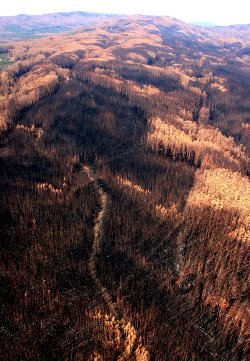
Forest Solutions
Confidence Experience Knowledge
Aiding Recovery, Assisting Restoration, and Building Resilience for Australia's Temperate Forests
Forest recovery |
  
|
 Australia's native forests are generally quite resilient to change, and usually have a capacity to self-recover or adjust. However, forest resilience is not only about long-term adaptation and repair; it is also about a forest's ecological capacity (or incapacity) to respond quickly to dramatic short-term impacts, such as bushfires, wind storms, human disturbances such as timber harvesting, fauna population imbalances, severe insect damage (such as the 1990s psyllid infestation in Mountain Ash), and even rapid changes in climate.
Australia's native forests are generally quite resilient to change, and usually have a capacity to self-recover or adjust. However, forest resilience is not only about long-term adaptation and repair; it is also about a forest's ecological capacity (or incapacity) to respond quickly to dramatic short-term impacts, such as bushfires, wind storms, human disturbances such as timber harvesting, fauna population imbalances, severe insect damage (such as the 1990s psyllid infestation in Mountain Ash), and even rapid changes in climate.
Following some impacts, native forests are simply unable to recover. It's all about the timing of change and the alignment of many complex components of the ecological system required for rehabilitation. For example, if a bushfire occurs in Australia's tall Ash forests at a time when seed is not present or mature in the forest canopy, the forest stand will not regenerate. This actually occurred in many Alpine Ash locations in the Victorian Alps following the 2006 Great Alpine Fire. Long term drought reduced the frequency of flowering events, resulting in a lack of seed at the time the fire occurred, and Forest Solutions worked rapidly with DSE to maintain and assist resilience in high priority localities such as young forest stands which could not self-regenerate.
Activities such as timber harvesting require direct and rapid intervention following the operation. Ecological processes such as bushfire and natural seedfall need to be understood and mimicked to provide conditions and seed for forest regeneration. At Forest Solutions we are expert in rehabilitating forests subjected to such scenarios.
Forest Solutions utilises its award winning Rapid Response process - now an integral part of DSE's silviculture response to bushfire. The techniques of monitoring and assessment of damage used in this process are adaptable to many scenarios, such as monitoring dieback due to agents such as psyllid, faunal population imbalances, and fungal infections. At our disposal are tools and systems that we can use in the forest, both vehicle or foot based, and from various aerial platforms.
We stand ready to assist you to restore and rehabilitate forests.
See more images related to forest recovery
